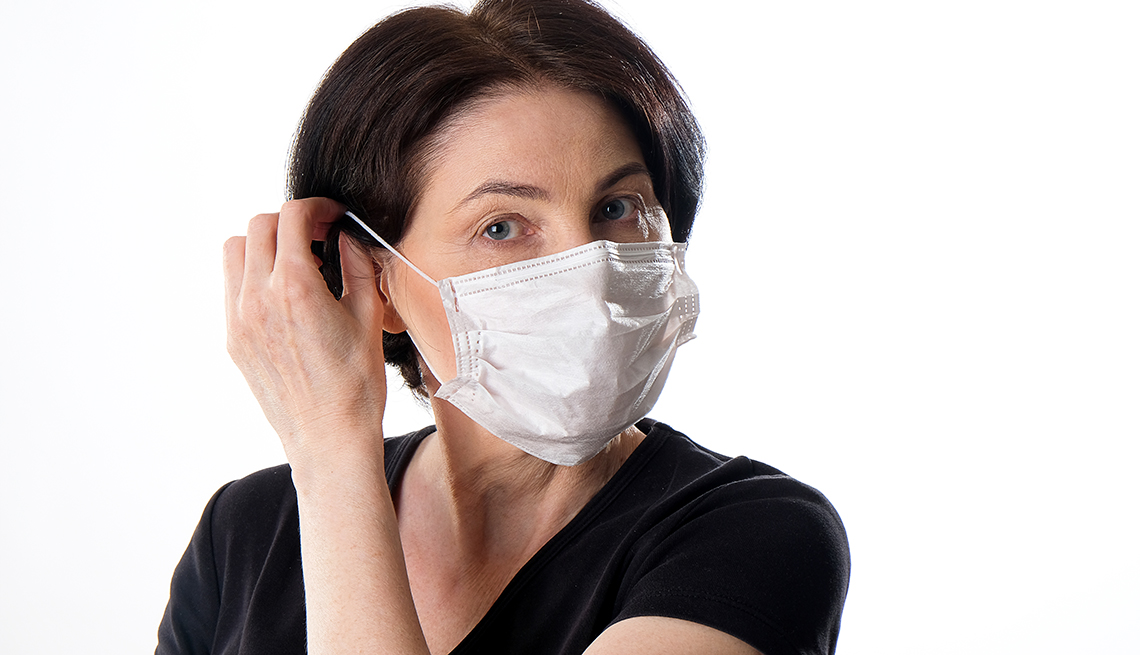
Do fully vaccinated people still need to wear masks?
- Select a language for the TTS:
- UK English Female
- UK English Male
- US English Female
- US English Male
- Australian Female
- Australian Male
- Language selected: (auto detect) - EN
Play all audios:

2. CONSIDER YOUR OWN RISK TOLERANCE In addition to looking at what's happening in your community, it's also important to consider the level of risk you're comfortable with.
There are plenty of people, especially those who are otherwise healthy, who may decide that getting back to pre-pandemic life is worth the small chance of getting mildly ill. "That
becomes very different if they're living at home with people who they could potentially infect,” says Wen, who like many Americans has small children who are not yet eligible for the
vaccines. The risk of a vaccinated individual contracting COVID-19 and passing it on to others is very low, according to the latest research. But it's not zero, which is why Wen still
wears a mask in crowded indoor settings, like the grocery store or church. People who are immunocompromised or have other health conditions that make it harder to fend off illnesses may also
be more cautious when going out in public. Then there are folks “who are very risk-averse and don't even want a mild or asymptomatic breakthrough, and that's fine,” Gandhi adds.
William Schaffner, M.D., an infectious disease expert and professor of medicine at the Vanderbilt University School of Medicine, offers up another analogy to help people understand risk
tolerance. He suggests thinking about everything we do to prevent the spread of COVID-19 like a series of slices of Swiss cheese. “Each one produces a barrier, but none of them is perfect.
They each have little holes in them,” he says. The vaccine is the thickest layer of cheese and the one with the fewest holes. “But it still has some holes. After all, under the best of
circumstances, the vaccines are 95 percent protective — you didn't hear me say 100 percent. And we know that some people who are immunocompromised in a variety of ways may not respond
optimally to the vaccines. So there are still opportunities to do some other things, particularly if you wish to be extra cautious,” Schaffner says. Federal health leaders have echoed the
importance of individual choice in the matter. National Institute of Allergy and Infectious Diseases Director Anthony Fauci said in a recent press briefing that older adults and people with
underlying health conditions “might want to go the extra mile of protection” by wearing a mask when in an indoor area in a community where there's a high degree of infection and a low
level of vaccination. "That is not a mask recommendation; that's just for consideration of each individual [with] their own level of the risk that they would like to take,” Fauci
said. “And there are many individuals who would feel — because of age or because of an underlying condition — that they might want to wear a mask.” 3. DIFFERENT SETTINGS MAY CALL FOR
DIFFERENT ACTIONS All three experts agree that masks really aren't needed when you're outside — consider the fresh, open air a “safe zone,” Gandhi says. Even unvaccinated
individuals don't need masks in most outdoor settings, according to the CDC. There is one exception: an outdoor sporting event where thousands of fans are seated close together and lots
of shouting and cheering is taking place. Some stadiums have sections specifically for fully vaccinated fans. However, if you're in an area where you could be around unvaccinated
people, you may want to bring your mask with you. The same consideration should be given for a beach trip or other outdoor travel excursions. Spending time on the beach or hiking in the
woods is a very low-risk activity. “But there's the hotel, there's the restaurant, we go to playgrounds, we go to other things, particularly in indoor venues,” Schaffner says.
Plus, it's important to remember that masks are still required on planes, buses, trains and other forms of public transportation in the U.S. DINING IN RESTAURANTS is one activity many
Americans are anxious to get back to. Wondering whether it's safe to do so, since you'll be without a mask for the majority of the meal? That's one scenario where your
personal risk tolerance comes into play. Schaffner and his wife recently dined indoors with a group of friends. “That was a big move for us,” he says, noting that he has yet to get on an
airplane and still prefers virtual meetings to in-person conferences. However, everyone at his table was fully vaccinated and the servers wore masks. Some restaurants also present fewer
risks than others, with lots of space and good ventilation. “But if you're going to be packed in a bar and no one is wearing masks and it's really loud and people are shouting at
one another and it's not very well ventilated, that is a very high-risk setting,” says Wen, who adds that she will not go to indoor restaurants unless she's certain the people
around her are fully vaccinated. "Think about it this way: Risk is cumulative. So the chance of you going to a restaurant and acquiring coronavirus that one time, if you're
vaccinated, is probably low. But if you're going to a crowded bar every night, especially in an area of high coronavirus transmission, at some point, the raincoat [or the protection
provided by the vaccine] may not work and you could get infected,” she says.
